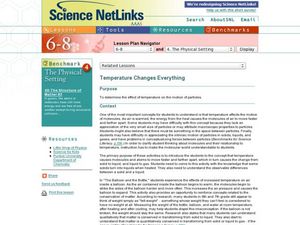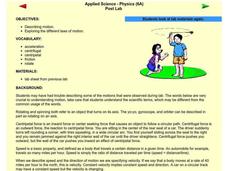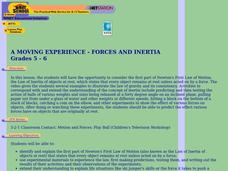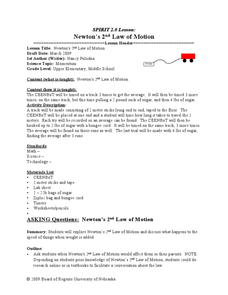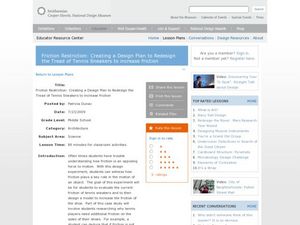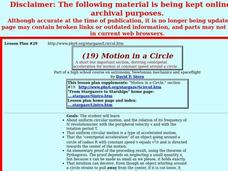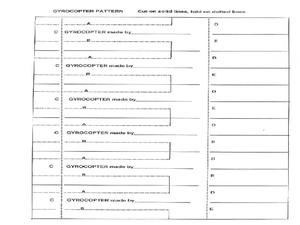Curated OER
Temperature Changes Everything
Middle school chemists visit interactive websites in order to discover what happens to molecular motion when heat is added to matter. They conduct an experiment that demonstrates the expansion of matter with the addition of heat. A lab...
Curated OER
Forces Applied to an Object
Fourth graders predict, observe, and compare what happens when a force is applied to an object. In this forces lesson, 4th graders complete a 'swinging hammer' activity to learn about forces and motion.
Curated OER
Laws of Motion
Students explore centrifugal and centripetal force. In this motion instructional activity, students expand on their knowledge of motion to study velocity, acceleration, and friction. Students examine multiple objects to demonstrate the...
Curated OER
Simple Machines
Students explore the concepts of force and effort by observing simple machines. In this physics lesson, students attempt to sharpen a pencil without any help, bite into an orange with their lips curled over their teeth, and other...
Curated OER
Race the Track! Design Challenge
Students use the design process to investigate physical science. For this force and motion lesson, design a track to achieve a specified outcome. Students complete additional experiments with speed and distance. Students...
Curated OER
A Moving Experience - Forces and Inertia
Students view a video and complete corresponding activities to observe inertia. They observe and predict the effect various forces have on objects.
Curated OER
Newton's 2nd Law of Motion
Students investigate how mass affects the speed of an object. In this physics lesson, students record data on the data table and graph results. They analyze findings and formulate a conclusion.
Curated OER
Friction Restriction: Creating a Design Plan to Redesign the Tread of Tennis Sneakers to Increase Friction
Young scholars evaluate the friction of tennis sneakers and redesign them to increase friction. For this physics lesson, students calculate starting, sideways and forward stopping friction. Using quantitative data, they prove that...
Curated OER
Circular Motion: Target Practice
Students demonstrate direction of velocity of an object in circular motion. They discuss the mathematical formula, and demonstrate the formula using a string, rubber stopper and a target.
Curated OER
Newton's Laws of Motion
Learners investigate the effect of thin films to surface friction. In this physics lesson, students calculate the coefficient of friction using mathematical formulas. They discuss its importance in their everyday lives.
Curated OER
MOTION IN A CIRCLE
Young scholars explore uniform circular motion, and the relation of its frequency of N revolutions/sec with the peripheral velocity v and with the rotation period T, and the "centripetal acceleration" of an object.
Curated OER
"Measurement in Motion"
Ninth graders examine the rate of motion and changes in motion using a ramp and a rolling object. They conduct the demonstration, determine the average speed, and describe how a moving object can have zero acceleration and deceleration.
Curated OER
Creating Magnetic Forces
Students discover magnetic forces. In this magnetic experiment instructional activity, students explore magnetism. Students conduct experiments and discover magnetic poles and magnetic strength.
Curated OER
Transfer of Motion and Force
Students work in groups to discover how to move an object down a zip line. For this engineering design lesson, students find how to use a cup to move a marble, the most efficient way. Students explain the...
Curated OER
May The Force Be With You
Eighth graders investigate Newton's Laws of Motion. They use the example of a roller coaster for illustration purposes. A force associated with a roller coaster is tested, data graphed, and a conclusion is drawn. They use excel in order...
Curated OER
What Does Motion Have to do with Sound?
Second graders investigate and explore sound energy. They investigate how the vibrational motion moves through matter in waves. Students describe sounds and vibrations. They observe that vibrational motion creates sounds. Students record...
LABScI
Potential and Kinetic Energy: The Roller Coaster Lab
Ron Toomer, a famous roller coaster designer, suffered from motion sickness. Pupils design their own roller coasters, learning about potential and kinetic energy in the process. Labs focus on the importance of drop height, energy...
Kenan Fellows
Analyzing Speed from Different Modalities
Show us your moves. Using sensor equipment, scholars track the motion of different movements, such as jogging, skipping, or jump roping. They analyze velocity and acceleration and create graphs representing each movement.
LABScI
Kinematics: The Gravity Lab
Falling objects can be brutal if you don't protect your noodle! Scholars explore the motion of falling objects through measuring short intervals to determine if the distance traveled varies with time. Building off of this, scholars...
Workforce Solutions
Newton's Laws
Two lessons explore the connection between energy transformation and a given job. In lesson one, small groups role-play a scenario that showcases the energy transformations that may take place during a job-specific task. The second...
Curated OER
Introduction to Forces and Inertia
Students explore the basic underlying concepts of Newton's first law of motion. They discuss forces and brainstorm different examples of force and what they act on. Students examine force by observing springs and gravity. They discuss...
Curated OER
Forces and Newton's Laws Unit
Students participate in lessons on Forces and Newton's Laws by selecting activities and assignments to complete in a Layer Unit. Students select assignments and activities in the C Level, B Level, and A Level.
Curated OER
Gyrocopters-Producing Rotary Motion
Students demonstrate rotary motion by practicing with gyrocopters. For this physics lesson students work in groups to construct a gyrocopter and explore how physics effect it torque and inertia.
Curated OER
Flicking With Force
Third graders are introduced to the concept of force and how it acts upon objects. In groups, they are given a ruler, ping-pong ball and golf ball and compare and contrast the force put on the balls when flicked by the ruler. To end...
